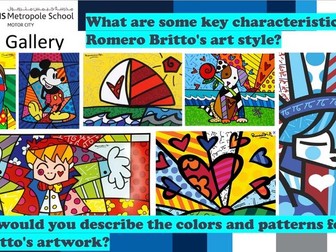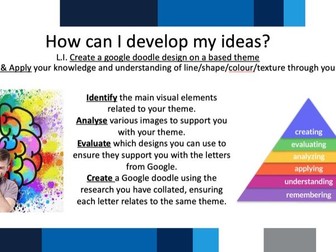
Romero Britto
Introduction to Romero Britto
Objective:
Students will learn about the artist Romero Britto, explore his unique style, and delve into typography. They will then create their names in the style of Britto, using his mark-making techniques, and be encouraged to develop their own creative variations.
Who is Romero Britto?
Romero Britto is a Brazilian artist known for his vibrant and colourful artwork that combines elements of pop art, cubism, and graffiti. His work often features bold patterns, playful themes, and a sense of joy and optimism.
Britto’s Style:
Bright Colours: Britto’s artwork is characterised by the use of bright, eye-catching colours.
Bold Lines: Thick, black outlines define the shapes in his paintings.
Patterns: He often incorporates a variety of patterns, such as polka dots, stripes, and geometric shapes.
Playful Themes: His art frequently includes hearts, stars, flowers, and happy characters.
Exploring Typography:
Typography is the art and technique of arranging type to make written language legible, readable, and visually appealing. In this lesson, students will focus on:
Font Styles: Different styles of lettering and their impact.
Composition: How the arrangement of letters and words affects the overall design.
Creativity: Incorporating personal style and artistic elements into typography.
Activity: Create Your Name in Britto’s Style
Research and Inspiration: Students will look at examples of Romero Britto’s artwork and identify common elements.
Sketching: Each student will sketch their name, incorporating bright colours, bold lines, and various patterns inspired by Britto’s style.
Mark-Making Techniques: They will use different mark-making techniques to add texture and depth to their letters.
Personal Touch: Encourage students to add their own unique elements and creativity to their designs.
Materials Needed:
Coloured markers, pencils, or paints
Black markers for outlines
Paper
Reference images of Romero Britto’s artwork
Outcome:
By the end of the lesson, students will have a better understanding of Romero Britto’s artistic style and the basics of typography. They will have created a personalised piece of art that reflects both their name and their creative interpretation of Britto’s techniques.

